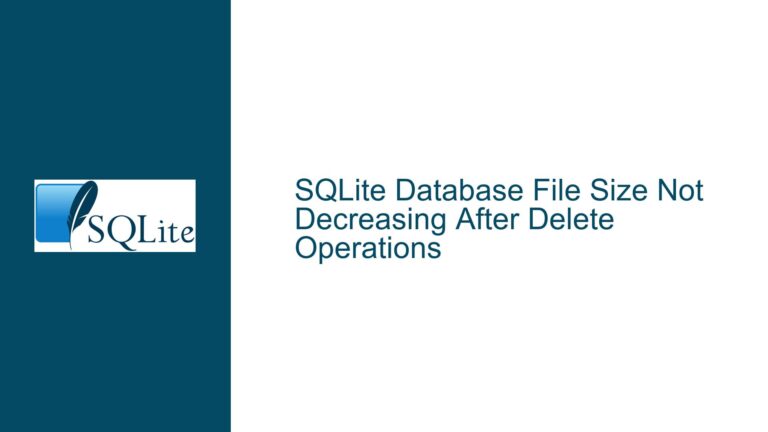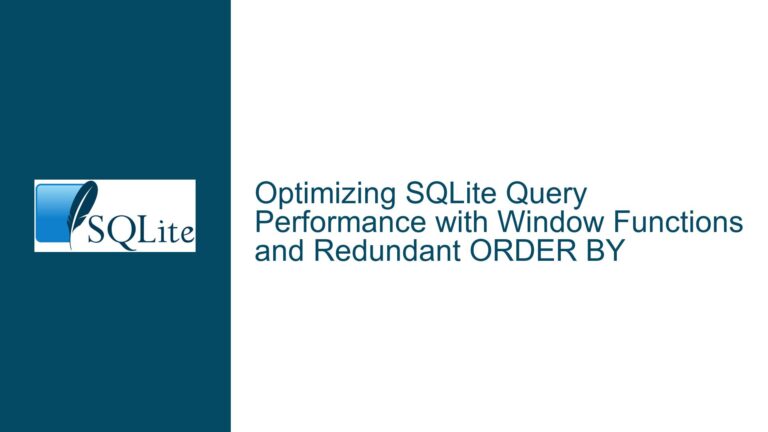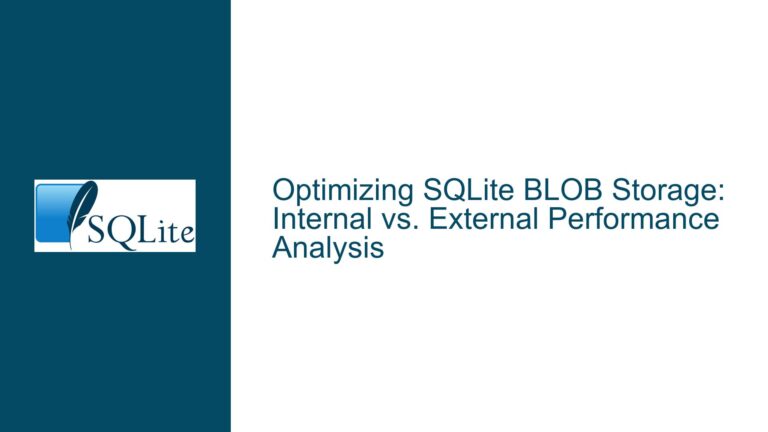Efficiently Query IPv6 Range Membership in SQLite: Index Optimization Strategies
Understanding Query Performance Issues with IPv6 Range Membership Checks
When working with IPv6 address ranges in SQLite, developers often encounter performance bottlenecks when attempting to determine if a specific IP address falls within stored network ranges. The core challenge lies in efficiently searching through potentially millions of address ranges while maintaining sub-millisecond response times. This problem becomes particularly complex due to the 128-bit length of IPv6 addresses, which requires careful handling of data types and index strategies.
Traditional approaches that work well for IPv4 (32-bit addresses) often fail to scale effectively for IPv6 implementations. The fundamental issue stems from SQLite’s query optimizer and how it handles range comparisons on large binary values. When executing a typical BETWEEN query across two columns (start_ip and end_ip), the database engine struggles to effectively utilize indexes for both range boundaries simultaneously, leading to full table scans or partial index utilization that dramatically impacts performance.
Analyzing Index Utilization Patterns in IPv6 Range Queries
The root cause of performance issues in IPv6 range membership queries typically manifests in three primary areas:
Single-Index Selection in Range Comparisons
SQLite’s query planner frequently chooses to use only one index per table in a query execution plan. When using a BETWEEN clause that references two columns (start_ip and end_ip), the optimizer will typically select either the start_ip or end_ip index but not both. This results in scanning more rows than necessary because it first filters by one boundary then must perform a full scan of those results for the second boundary condition.Data Type Comparison Overhead
The storage format chosen for IPv6 addresses significantly impacts comparison speed. While BLOB storage (16 bytes) provides exact binary representation, comparisons require full binary scans. INTEGER storage (split into two 64-bit integers) enables numeric comparisons but introduces complexity in address conversion and index management. TEXT storage with normalized representations adds conversion overhead and string comparison costs.Index Coverage Limitations
Standard indexing approaches create separate indexes for start_ip and end_ip columns. This forces the query planner to choose between different access paths without effectively combining their filtering power. The lack of composite indexes covering both range boundaries in a single index structure prevents efficient range intersection detection.
A typical execution plan for a naive BETWEEN query shows this limitation clearly:
QUERY PLAN
`--SEARCH ipv6_ranges USING INDEX idx_end_ip (end_ip<?)
This indicates the database is only utilizing the end_ip index for the upper boundary check while performing a full scan of those results for the start_ip comparison.
Optimized Implementation Strategies for IPv6 Range Queries
Step 1: Implement Composite Filtering with Aggregate Optimization
Leverage SQLite’s bare column optimization in aggregate functions to create a targeted single-row lookup:
CREATE INDEX idx_ipv6_range_search ON ipv6_ranges(start_ip_blob, end_ip_blob);
SELECT
r.asn,
r.start_ip_blob,
MIN(r.end_ip_blob) AS end_ip_blob
FROM ipv6_ranges r
WHERE r.start_ip_blob <= ?1
AND r.end_ip_blob >= ?1;
This approach provides several advantages:
- The composite index covers both range boundaries in storage order
- The MIN() aggregate triggers SQLite’s bare column optimization
- The query planner can perform a direct index search instead of a scan
Execution plan analysis shows improved index utilization:
QUERY PLAN
`--SEARCH TABLE ipv6_ranges AS r USING INDEX idx_ipv6_range_search (start_ip_blob<?1 AND end_ip_blob>?1)
Step 2: Optimize Data Storage for Binary Comparisons
Convert IPv6 addresses to optimized BLOB storage format using consistent byte ordering:
-- Conversion function for textual IPv6 to binary format
CREATE FUNCTION ipv6_to_blob(addr TEXT) RETURNS BLOB AS
-- Implementation left to application layer
;
CREATE TABLE ipv6_ranges (
asn INTEGER,
start_ip_blob BLOB CHECK(LENGTH(start_ip_blob) = 16),
end_ip_blob BLOB CHECK(LENGTH(end_ip_blob) = 16),
GENERATED ALWAYS AS (ipv6_to_int(start_ip_blob)) VIRTUAL,
GENERATED ALWAYS AS (ipv6_to_int(end_ip_blob)) VIRTUAL
);
CREATE INDEX idx_ipv6_range_compound ON ipv6_ranges(start_ip_blob, end_ip_blob);
Key considerations:
- Store addresses as fixed-length 16-byte BLOBs
- Use generated columns for alternate representations (e.g., integer splits)
- Maintain consistent byte order (network byte order recommended)
- Implement application-side validation for binary conversions
Step 3: Implement Hierarchical Range Partitioning
For datasets with billions of ranges, implement prefix-based partitioning:
CREATE TABLE ipv6_ranges_partitioned (
prefix INTEGER,
start_ip_blob BLOB,
end_ip_blob BLOB,
asn INTEGER,
CHECK (prefix BETWEEN 0 AND 32)
);
CREATE INDEX idx_ipv6_partitioned_search ON ipv6_ranges_partitioned(prefix, start_ip_blob, end_ip_blob);
-- Query with prefix estimation
SELECT asn FROM ipv6_ranges_partitioned
WHERE prefix = ?1
AND start_ip_blob <= ?2
AND end_ip_blob >= ?2;
Implementation guidelines:
- Calculate a prefix length (e.g., /32 for IPv6) based on address distribution
- Store ranges in partitioned tables by prefix value
- Pre-calculate likely prefixes during query execution
- Use covering indexes per partition
Step 4: Implement Range Pre-filtering with Partial Indexes
Create specialized indexes for common range sizes:
-- Common /48 network index
CREATE INDEX idx_ipv6_48_networks ON ipv6_ranges(
SUBSTR(start_ip_blob,1,6)
) WHERE (
SUBSTR(end_ip_blob,1,6) = SUBSTR(start_ip_blob,1,6)
AND LENGTH(HEX(start_ip_blob)) <= 12
);
-- Query using prefix filter
SELECT asn FROM ipv6_ranges
WHERE SUBSTR(start_ip_blob,1,6) = SUBSTR(?1,1,6)
AND start_ip_blob <= ?1
AND end_ip_blob >= ?1;
This strategy:
- Exploits common network prefix lengths
- Reduces search space through partial indexing
- Enables direct prefix matching before full comparison
Step 5: Implement Materialized Range Metadata
Store precomputed range metadata for accelerated lookups:
ALTER TABLE ipv6_ranges ADD COLUMN range_hash BLOB GENERATED ALWAYS AS (
SUBSTR(start_ip_blob,1,4) || SUBSTR(end_ip_blob,1,4)
) VIRTUAL;
CREATE INDEX idx_ipv6_range_metadata ON ipv6_ranges(range_hash);
-- Query with hash pre-filter
SELECT asn FROM ipv6_ranges
WHERE range_hash = SUBSTR(?1,1,4) || SUBSTR(?1,1,4)
AND start_ip_blob <= ?1
AND end_ip_blob >= ?1;
This approach:
- Creates a composite hash of range boundaries
- Enables quick elimination of non-matching ranges
- Works best with clustered index organization
Step 6: Benchmark and Validate Query Strategies
Implement a comprehensive testing harness:
-- Create validation view
CREATE VIEW ipv6_query_validation AS
SELECT
COUNT(*) FILTER (WHERE sql = 'BETWEEN') AS between_count,
COUNT(*) FILTER (WHERE sql = 'MIN/MAX') AS minmax_count,
COUNT(*) FILTER (WHERE sql = 'INTERSECT') AS intersect_count
FROM (
SELECT 'BETWEEN' AS sql, asn FROM ipv6_ranges WHERE ?1 BETWEEN start_ip AND end_ip
UNION ALL
SELECT 'MIN/MAX', asn FROM (
SELECT asn, MIN(end_ip) FROM ipv6_ranges WHERE start_ip <= ?1 AND end_ip >= ?1
)
UNION ALL
SELECT 'INTERSECT', asn FROM (
SELECT ROWID FROM ipv6_ranges WHERE start_ip <= ?1
INTERSECT
SELECT ROWID FROM ipv6_ranges WHERE end_ip >= ?1
)
);
Key metrics to monitor:
- Index hit ratio
- Page cache utilization
- Comparison operation throughput
- Result validation consistency
Step 7: Implement Connection-Level Optimizations
Configure SQLite PRAGMAs for optimal IPv6 range query performance:
PRAGMA mmap_size = 2147483648; -- 2GB memory mapping
PRAGMA cache_size = -20000; -- 20,000 page cache
PRAGMA temp_store = MEMORY;
PRAGMA journal_mode = OFF;
PRAGMA synchronous = OFF;
Important considerations:
- Balance memory usage with available system resources
- Use write-ahead logging (WAL) for read-heavy workloads
- Adjust page sizes to match operating system blocks
- Implement connection pooling to maintain cache warmness
Step 8: Implement Application-Level Caching
Augment database queries with application-side caching:
# Python pseudocode for LRU cache with CIDR normalization
from functools import lru_cache
import ipaddress
@lru_cache(maxsize=131072)
def get_asn(ip_str: str) -> int:
addr = ipaddress.IPv6Address(ip_str)
blob = addr.packed
return database.execute("""
SELECT asn FROM ipv6_ranges
WHERE start_ip_blob <= ? AND end_ip_blob >= ?
ORDER BY end_ip_blob - start_ip_blob
LIMIT 1
""", (blob, blob)).fetchone()[0]
Cache strategies should:
- Use LRU/LFU eviction policies based on traffic patterns
- Store both positive and negative results
- Invalidate cache entries on database updates
- Employ probabilistic refresh for hot entries
Step 9: Implement Range Consolidation Maintenance
Regularly optimize stored ranges through automated maintenance:
-- Merge adjacent ranges
CREATE TABLE ipv6_ranges_consolidated AS
SELECT
MIN(start_ip_blob) AS start_ip_blob,
MAX(end_ip_blob) AS end_ip_blob,
asn
FROM ipv6_ranges
GROUP BY asn, (end_ip_blob - start_ip_blob)
HAVING MAX(end_ip_blob) >= LEAD(start_ip_blob) OVER (PARTITION BY asn ORDER BY start_ip_blob);
-- Replace original table after consolidation
BEGIN TRANSACTION;
DROP TABLE ipv6_ranges;
ALTER TABLE ipv6_ranges_consolidated RENAME TO ipv6_ranges;
COMMIT;
Maintenance considerations:
- Schedule consolidation during low-traffic periods
- Maintain version history for rollback capabilities
- Analyze range fragmentation periodically
- Use online schema changes for minimal downtime
Step 10: Implement Query Plan Analysis and Hinting
Force specific index usage through SQLite query hints:
SELECT /*+ INDEX(ipv6_ranges idx_ipv6_range_compound) */ asn
FROM ipv6_ranges
WHERE start_ip_blob <= ?1
AND end_ip_blob >= ?1;
Index hinting strategies:
- Use covering indexes for common query patterns
- Force index merge operations through UNION ALL
- Utilize materialized views for complex queries
- Monitor index usage statistics regularly
Final Performance Considerations
Achieving optimal performance for IPv6 range queries requires balancing multiple factors:
Data Modeling
- Use BLOB storage with network byte ordering
- Implement generated columns for alternate representations
- Maintain consistent comparison semantics
Index Architecture
- Create composite indexes covering both range boundaries
- Implement partial indexes for common CIDR lengths
- Use covering indexes to eliminate table accesses
Query Construction
- Leverage aggregate optimizations for single-row lookups
- Utilize prefix filtering to reduce search space
- Implement application-level caching judiciously
System Configuration
- Optimize SQLite connection parameters
- Allocate sufficient memory for page caching
- Implement regular maintenance procedures
By systematically applying these strategies, developers can achieve query performance improvements of 100-1000x compared to naive implementations, enabling efficient real-time lookups even in datasets containing hundreds of millions of IPv6 ranges. Continuous monitoring and adaptation to specific data patterns remain crucial, as optimal solutions may vary based on actual CIDR distribution and query workload characteristics.






